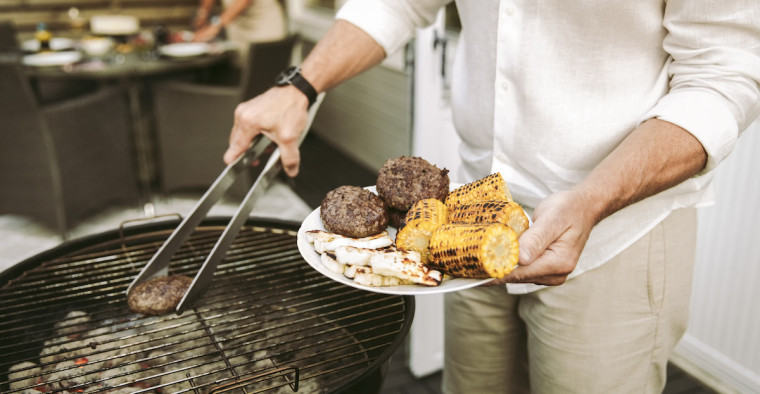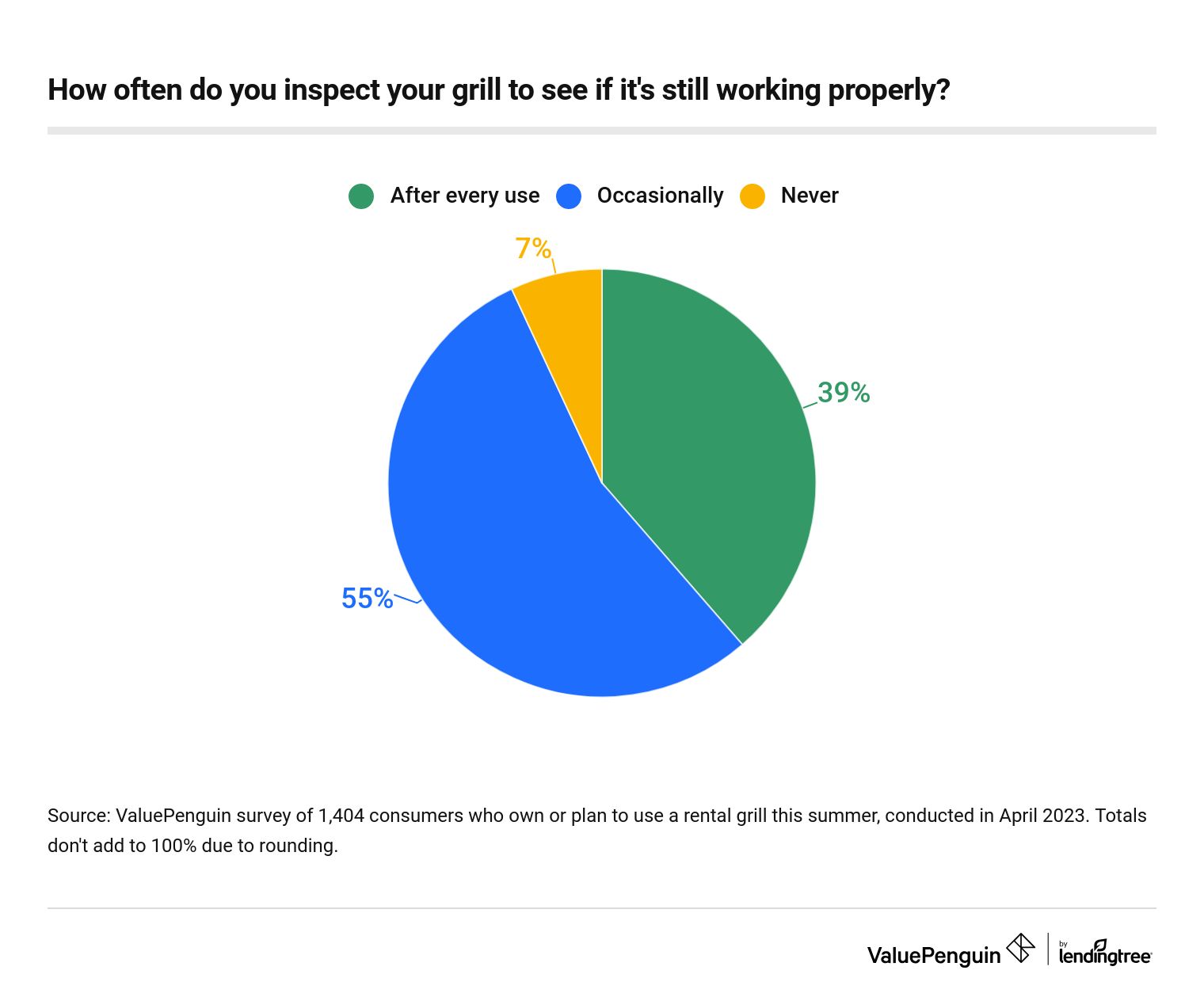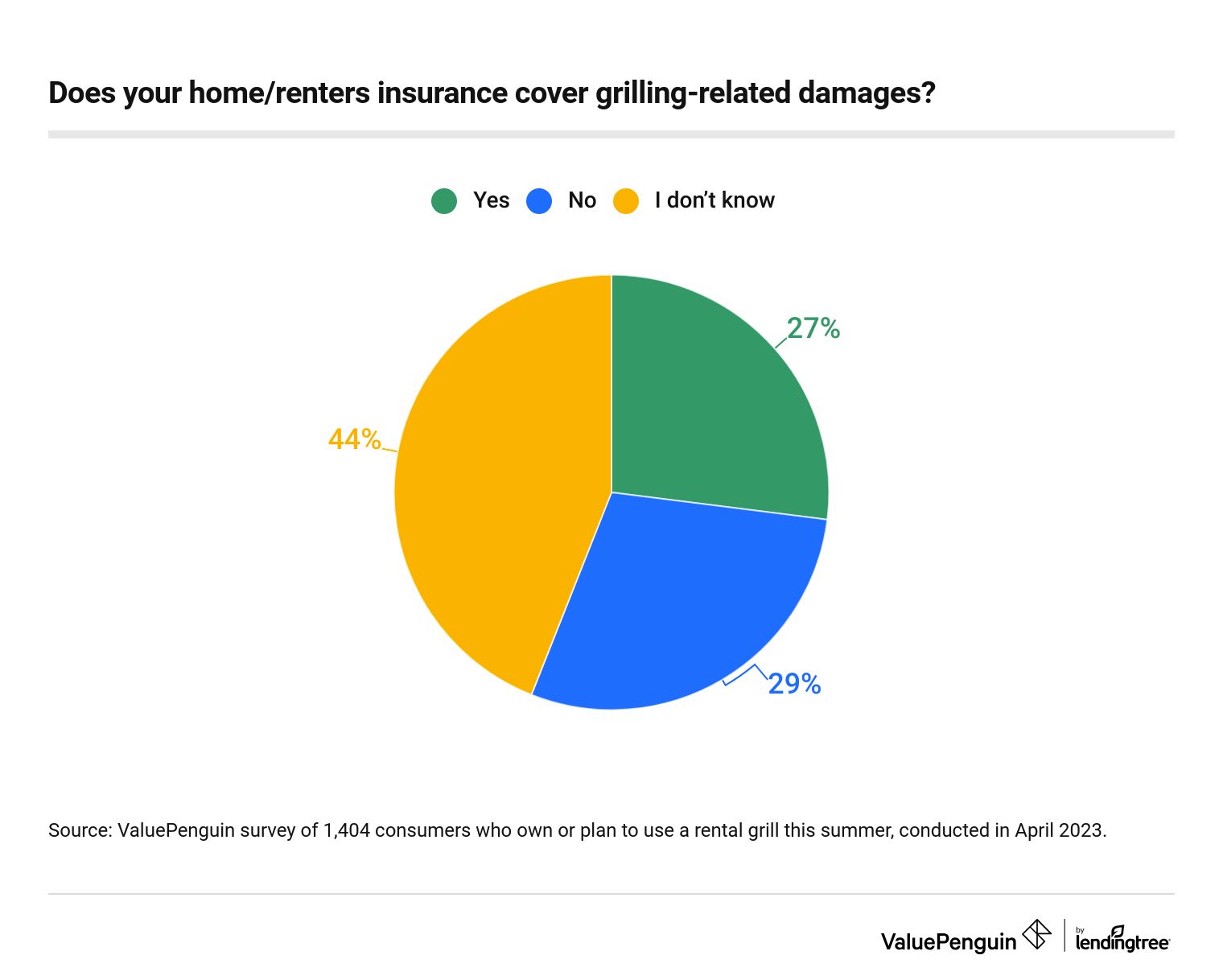Homeowners Insurance
Pit Masters of Mistakes? Grilling Injuries More Common Among Gen Zers, Millennials and Men

Summer is almost here, and many Americans are eagerly preparing their grills for backyard barbecues. However, this popular pastime comes with its share of risks. In fact, according to the latest ValuePenguin survey of 2,000 U.S. consumers, nearly 15% of this summer's backyard chefs say they've been injured grilling.
Here's what else we found.
On this page
- Key findings
- Nearly 15% of those who own or plan to use a vacation rental grill this summer have been injured grilling
- 30% admit to buzzed barbecuing
- 21% of parents with children younger than 18 have let their kids grill unsupervised
- Consumers are typically lax when it comes to grill maintenance
- 44% of consumers don't know if their homeowners insurance covers grilling-related damages
- Home insurance and barbecuing: What to know
- Methodology
Key findings
- As summer grows closer, many Americans are firing up their grills, but this doesn't come without risks. Among the 70% of consumers who own or plan to use a vacation rental grill this summer, nearly 15% say they've been injured grilling. Men are nearly three times more likely than women to injure themselves while grilling, while Gen Zers lead the age groups at 25%. Overall, burns are the most common injury at 63%.
- Americans are no stranger to — but in danger of — buzzed barbecuing, as 30% of grill owners or renters admit to grilling while intoxicated. Millennials lead the way in grilling under the influence at 44%, and men are much more likely to grill with a buzz than women (43% versus 18%). In contrast, baby boomers are the most responsible outdoor chefs, with only 12% admitting to being intoxicated while cooking.
- Given all the grilling hazards, it's surprising that 21% of parents with children younger than 18 have let their kids grill unsupervised. Children younger than 10 accounted for the highest rate of emergency department visits for grill-related accidents (21%) from 2012 to 2021, according to a 2022 ValuePenguin report.
- Out of sight, out of mind. Once the food is consumed, proper grill maintenance isn't a top priority — but it should be. Among those who own or plan to use a vacation rental grill this summer, 62% say they don't always inspect the grill to make sure it's working properly, and 42% say they don't clean their grill after every use. Improperly cleaned or poorly maintained grills are involved in 29% of home grill structure fires, according to the National Fire Protection Association.
- Optimistic, unaware — or do they not care? More than 4 in 10 (44%) of those planning to grill this summer don't know if their homeowners or renters insurance policies cover grilling-related damages, and 29% incorrectly think they aren't covered. In particular, 62% of baby boomers and 53% of women don't know if they're covered. Not knowing or reviewing policies could lead to insufficient house and structure, personal property or liability coverage.
Nearly 15% of those who own or plan to use a vacation rental grill this summer have been injured grilling
Warmer weather may mean it's time to dust off the grill. While barbecues may be fun (and popular, as 53% of consumers plan to host or attend a barbecue this summer), they sometimes come with injury. Of the 70% of consumers who own or plan to use a vacation rental grill this summer, 14% say they've been injured grilling.
Notably, men are nearly three times more likely than women to injure themselves while grilling, at 19% versus 7%. Meanwhile, a quarter (25%) of Gen Zers (ages 18 to 26) have injured themselves grilling, making them the most likely age group to do so. That's followed by:
- Millennials (ages 27 to 42) (22%)
- Gen Xers (ages 43 to 58) (7%)
- Baby boomers (ages 59 to 77) (3%)
According to ValuePenguin home insurance expert Divya Sangameshwar, grilling injuries may come from improper use.
"It's heartening to see that almost 85% of Americans are careful when handling the grill, but for those who injure themselves barbecuing, inexperience with cooking over the grill could be a factor," she says. "Rookie mistakes, like dousing charcoal in lighter fluid, serving and eating undercooked meat, cooking on a grill that hasn't been cleaned and not using the vents properly all contribute to injuries. It's important that grillers exercise as much or more caution cooking over a grill as they would in a kitchen."
Perhaps unsurprisingly, burns are the most common type of injuries reported at 63%. Following that, further common injuries include food poisoning (37%), cuts (34%) and choking (14%). Also worrying, 8% report feeling dizzy or nauseous — which may result from a smoke allergy or, even worse, carbon monoxide poisoning.
Why is food poisoning so common? It may be because consumers aren't properly checking their meat. While 37% use a meat thermometer to check if their food is done, 29% use the eye test — making it the second most popular method. Gen Xers (34%), parents with adult children (33%) and men (32%) are particularly likely to use the eye test. Another 14% overall use the touch test and 8% use the taste test.
Consumers prefer gas grills, newer grills
Convenience comes before safety when it comes to grill types. Among this summer's backyard chefs, 47% typically use gas-powered grills, though that's particularly true of baby boomers (59%), Gen Xers (56%) and women (52%). However, it's also worth noting that gas grills account for 84% of home fires caused by outdoor cooking, according to the National Fire Protection Association (NFPA).
Following that, 42% generally use charcoal-powered grills — though they're particularly popular with millennials (49%), Gen Zers (46%) and men (44%). Meanwhile, only 11% of Americans commonly use pellet or electric grills.
Generally, most grill owners (51%) have one that’s between 2 and 4 years old, though 20% own one that's 1 year old or less and another 20% have one dating five to seven years. And who has the newest grills? Gen Zers (34%), Americans making less than $35,000 (29%), renters (29%), millennials (27%) and Americans with children younger than 18 (23%) are most likely to have a grill they’ve purchased in the past year.
30% admit to buzzed barbecuing
Barbecue and beer go hand-in-hand for a lot of outdoor chefs. In fact, 30% of consumers who own or plan to use a vacation rental grill this summer admit to grilling while intoxicated — and that's particularly true among millennials (44%) and men (43%). Meanwhile, older consumers and women tend to be more responsible — just 12% of baby boomers and 18% of women admit to drunk grilling.
Parents with children younger than 18 also tend to get boozy in the backyard, with 39% of this group admitting to grilling drunk. In comparison, 32% of consumers with no children and 18% of consumers with adult children say similarly.
Drinking and grilling can be a recipe for disaster, says Sangameshwar.
"Alcohol can make you drowsy and less vigilant, which is a bad idea around a grill with an open fire," she says. "It's also important to remember that the combination of alcohol and heat from the grill and the summer could make you vulnerable to dehydration and heat injuries."
21% of parents with children younger than 18 have let their kids grill unsupervised
Despite the hazards and percentage of injuries reported, 21% of parents with children younger than 18 have let their kids grill unsupervised. However, kids are particularly vulnerable to grilling injuries: In fact, a 2022 ValuePenguin report on grilling injuries found that children younger than 10 accounted for 21% of grilling-related emergency room visits between 2012 and 2021, highest of any age group.
While Sangameshwar is surprised so many parents leave their kids alone with the grill, she says that they don't have to forgo the summer barbecues to practice child safety.
"Spending time with your kids barbecuing over the summer creates great memories, as long as the adults keep an eye on the children and not allow them anywhere near a hot grill unsupervised," she says. "A good rule of thumb is the 3-foot rule: Keep children away from the grill area by declaring a 3-foot 'kid-free zone' around the grill. This rule should continue even after the barbecue is over — especially if the grill is still hot."
Consumers are typically lax when it comes to grill maintenance
For vacation rental grillers and owners, proper grill maintenance isn't a top priority. And while it may be convenient to skip a cleaning session or two, failing to do so may lead to complications. Among this summer's backyard chefs, 62% say they don't always inspect the grill to make sure it's working properly.

Women (64%) are more likely to cook without inspecting their grills after every use than men (58%). In addition, older consumers are more likely to skip the inspection than younger consumers. While 67% of baby boomers say they don't always inspect their grills, just 54% of Gen Zers say similarly.
Meanwhile, 42% say they don't clean their grill after every use. However, improperly cleaned or poorly maintained grills are involved in 29% of home grill structure fires, according to the NFPA.
"The two biggest aspects of grill maintenance are cleaning your grill and inspecting it for leaks, rust or other structural integrity problems," Sangameshwar says. "An improperly maintained grill can lead to disasters like grease fires, explosions from leaking propane tanks, severe illness from bacteria or mold, foul-tasting food from dirty grills with burnt stuck on meat or grills breaking down and falling apart from rust."
44% of consumers don't know if their homeowners insurance covers grilling-related damages
Property damage is the last thing consumers want to think about when planning a barbecue in their backyards — and the numbers prove many don't. In fact, 44% of those planning to grill this summer don't know if their homeowners or renters insurance policies cover grilling-related damages. However, not knowing or reviewing policies may mean you won't receive the house and structure, personal property or liability coverage you might be owed if damage occurs.
By demographic, baby boomers (62%), parents with adult children (58%) and women (53%) are the most likely to not know if their homeowners or renters insurance policies cover grilling-related damages.

Meanwhile, 29% incorrectly think they aren't covered. That's particularly true of Gen Zers (50%) and consumers earning less than $35,000 (40%).
Home insurance and barbecuing: What to know
While nothing says summer like a barbecue, it's crucial to come prepared — and that doesn't just mean bringing enough plates to share. The dangers of not knowing what your insurance covers could expose you to financial risk, especially if you're underinsured. For those hosting a barbecue this year, Sangameshwar says to keep in mind the following:
- If a grill fire broke out and spread to your property, your homeowners insurance provides financial protection, as fire is a covered peril. "Most standard policies will cover damage to the house, personal possessions like lawn furniture and damage to other structures on your property if you've insured them (like a shed or gazebo)," she says. "Your liability portion will also cover you in case a guest gets injured or sick on your property."
- However, your coverage is limited to your set maximums and what you've insured. Maybe you've made significant updates to your home, or built a new shed or gazebo. But if you haven't added that to your policy, or if your net worth increased recently but your liability coverage is low, you may be on the hook for the cost of repairs for your home or medical bills for your guests beyond what insurance will cover. If it's been a while, update your insurance policy before hosting your summer festivities.
Methodology
ValuePenguin commissioned QuestionPro to conduct an online survey of 2,000 U.S. consumers ages 18 to 77 from April 12-13, 2023. The survey was administered using a nonprobability-based sample, and quotas were used to ensure the sample base represented the overall population. Researchers reviewed all responses for quality control.
We defined generations as the following ages in 2023:
- Generation Z: 18 to 26
- Millennial: 27 to 42
- Generation X: 43 to 58
- Baby boomer: 59 to 77
